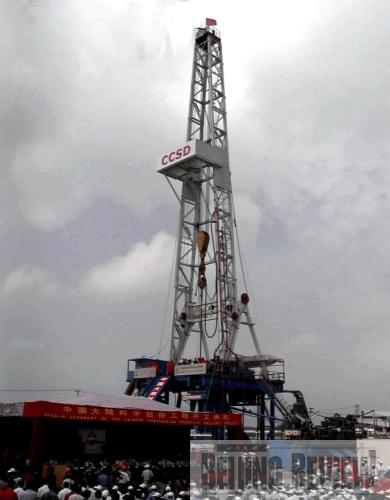|
 |
|
DEEP DOWN: China's Continental Scientific Drilling Program started operation in Donghai County, Jiangsu Province, on August 4, 2001 (SUN CAN) |
"This is the first time that China is set to study the mechanism of earthquake fractures soon after a big quake. This project is also the fastest response to a big earthquake in the world," said Xu.
She reported the team's progress over the past six months at a colloquium of the Chinese Academy of Geological Sciences (CAGS) held to commemorate the first anniversary of the Wenchuan Earthquake. "By May 11, the first borehole's depth was 744.82 meters. It had penetrated through ancient crystalline rock and was set to reveal the mysteries of the quake," said Xu.
Four discoveries
Xu said the first drill site has yielded a series of important discoveries. "From the drill core we find that the Beichuan-Yingxiu fault, part of the Longmen Mountain fault, is so vast and the fault rocks are of an interesting variety, including a rarely seen clay gouge deposit. These factors contribute to a big breakthrough for our earthquake mechanism study," said Xu.
Xu said the drill found the main fracture at a depth of 589 meters, shallower than expected. They had thought it rested 800 meters below the surface.
"The second discovery is more than 20 ancient fractures, which are the evidence of strong ground stress and periodic ancient earthquakes," Xu said, noting these new data would be important evidence for studying earthquakes and their periods.
Researchers also found a rarely seen 100-meter-thick fault gouge fracture 585 meters underground. Xu said it is uncommon to find them at a thickness exceeding 20 meters. The find is a record for Longmen Mountain and provides evidence for frequent strong earthquakes in the Beichuan-Yingxiu fracture.
Since the drilling started last November, researchers have monitored more than 3,000 aftershocks in the Longmen Mountain fault, finding a connection between shifting faults and abnormal amounts of helium, argon, methane and radon.
Researchers began a second 3,000-meter-deep borehole at the end of June.
The drilling work is difficult at the Longmen Mountain fault, which sits below mountains and valleys. Sometimes the borehole wall caves in or the rock grows too solid to drill. "This is the hardest borehole to drill; the difficulty is beyond our expectations," said Xu.
"For regular drilling through solid rock, it takes at most three months to finish the work. This is a different case, as we are doing drilling for the benefit of science," said Peng Hua, a researcher at the CAGS.
Scientific drilling has an important mission: obtaining a rock core sample the length of the borehole. Drillers must procure at least 85 percent of the hole's overall length, otherwise the sample loses its value. Xu must continuously remind the drillers that the team would rather go slow and obtain the whole rock core.
She said that being slow and steady is paying off, obtaining samples as high as 92 percent of the hole's length. "The engineers and technicians managed to get the integrated rock core, while guaranteeing safe drilling and providing us with good samples for scientific research," Xu said.
Underground telescope
Xu said that they would build China's second long-term earthquake observation station in the area. Xu also helms the first one, which is located in Donghai County, east China's Jiangsu Province.
The Donghai County observation station began operation on June 25, 2001, using a 5-km-deep borehole. After thousands of days of drilling, the team reached 5,158 meters below ground at the end of 2004. Its vertical length equaled a 1,700-floor building. The station became the world's third borehole deeper than 5 km, after one in the former Soviet Union and another in Germany.
The team was able to build an underground telescope, incorporating geophysical remote sensing technology with deep drilling technology. In 2007, the Continental Scientific Drilling Program, which took Xu and her colleagues 10 years to complete, was finally inspected and approved by authorities.
For generations, human beings have been trying to probe deep into the Earth, but have largely been thwarted by the obstacles created of solid rock. People know the planet is composed of a crust, a mantle and a core. Through observing and analyzing layers of rock, continental scientific drilling technology can help people more accurately understand crustal formations, structure and crustal movements. | 